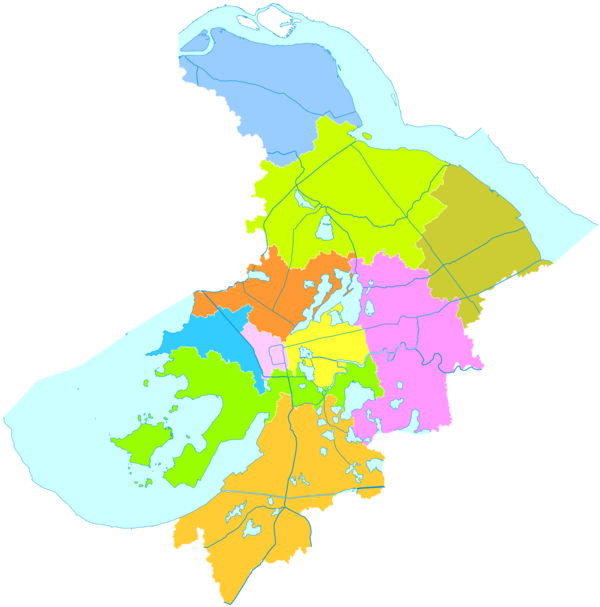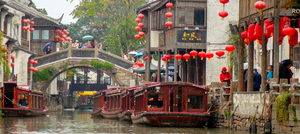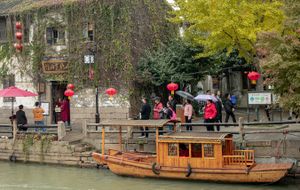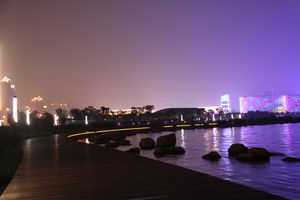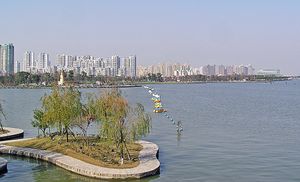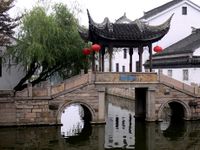سوژو
سوژو
苏州市 سوجو، Suzhou Sūzhōu Shì ، سوتشو | |
|---|---|
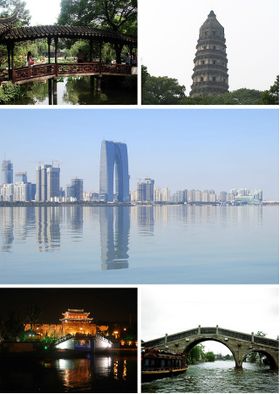 معالم سوژو — أعلى اليسار: حديقة الاداري المتواضع؛ أعلى اليمين: پاگودا يونيان في ربوة النمر؛ الوسط: أفق بحيرة جنجي؛ أسفل اليسار: بوابة تشانگمن بالليل؛ أسفل اليمين: قناة شانتانگ | |
الموقع في جيانگسو | |
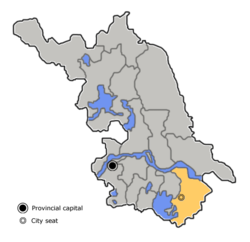 | |
| الإحداثيات: 31°18′N 120°36′E / 31.300°N 120.600°E | |
| البلد | الصين |
| المقاطعة | جيانگسو |
| التقسيمات بمستوى الناحية | 11 |
| تأسست | 514 ق.م. |
| الحكومة | |
| • النوع | مدينة بمستوى محافظة |
| • أمين الحزب الشيوعي الصيني في سوژو | Zhou Naixiang |
| • العمدة | Qu Futian |
| المساحة | |
| • مدينة بمستوى محافظة | 8٬488٫42 كم² (3٬277٫40 ميل²) |
| • البر | 6٬093٫92 كم² (2٬352٫88 ميل²) |
| • الماء | 2٬394٫50 كم² (924٫52 ميل²) |
| • الحضر | 2٬743 كم² (1٬059 ميل²) |
| التعداد (2019) | |
| • مدينة بمستوى محافظة | 11٬190٬000 |
| • الكثافة | 1٬300/km2 (3٬400/sq mi) |
| صفة المواطن | Suzhounese |
| منطقة التوقيت | UTC+8 (توقيت بكين) |
| Postal code | 215000 |
| مفتاح الهاتف | 512 |
| ISO 3166 code | CN-JS-05 |
| ن.م.إ. (2018) |
1.86 تريليون CNY
174,129 CNY
|
| م.ت.ب. (2015) | 0.909 very high[2] |
| زهرة المدينة | العبقة |
| شجرة المدينة | شجرة الكافور |
| اللهجة الإقليمية | وو: لهجة سوژو |
| سابقة لوحات السيارات | 苏E و 苏U[3] |
| الموقع الإلكتروني | www |
| سوژو | |||
|---|---|---|---|
 "سوژو" بالحروف الصينية المبسطة (أعلى) والتقليدية (أسفل) | |||
| الصينية المبسطة | 苏州 | ||
| الصينية التقليدية | 蘇州 | ||
| |||
سوژو (صينية وو: [soʊ˥ tsøʏ˨˩]), كما تُرَوْمن كالتالي Soochow، هي مدينة كبرى في جنوب شرق مقاطعة جيانگسو في شرق الصين، على بعد 100 كم شمال غرب شانغهاي. وهي مركز اقتصادي وبؤرة تجارية، وثاني أكبر مدينة في المقاطعة، بعد عاصمتها نانجينگ. وتقع المدينة أسفل نهر يانگتسى وعلى ضفاف بحيرة تاي وتتبع منطقة دلتا نهر يانگتسي. وإدارياً، فإن سوژو هي مدينة بمستوى محافظة بتعداد 4.33 مليون نسمة في المدينة نفسها، وإجمالي تعداد المقيمين (اعتبارا من 2013[تحديث]) هو 10.58 مليون نسمة في منطقتها الادارية.[4][5] نما تعدادها الحضري بالمعدل غير المسبوق، 6.5%، بين عامي 2000 و 2014، وهو الأعلى بين المدن الأكبر من 5 مليون نسمة.[6][7]
بتأسسها في 514 ق.م.، فإن لسوژو تاريخ يمتد لأكثر من 2,500 سنة، ولديها الكثير مما يمكنها عرضه من الآثار والمواقع ذات الأهمية التاريخية. وحوالي سنة 100، أثناء أسرة هان الشرقية، فقد أصبحت واحدة من أكبر عشر مدن في العالم، غالباً بسبب الهجرة من شمال الصين.[8][9] ومنذ أسرة سونگ في القرن العاشر، فقد أصبحت مركزاً تجارياً هاماً في الصين. وأثناء أسرتي مينگ و تشينگ، كانت سوژو مركزاً اقتصادياً وثقافياً وتجارياً على المستوى الوطني،[10] وكذلك أكبر مدينة غير عاصمة في العالم، حتى تمرد تايپنگ في 1860.[11] وحين عاود لي هونگژانگ و تشارلز جورج گوردون الاستيلاء على المدينة بعد ثلاث سنوات، كانت شانغهاي، بالفعل، قد استولت على مكانتها البارزة في الصين.[12] ومنذ بدأت الإصلاحات الاقتصادية الكبرى في 1978، أصبحت سوژو واحدة من المدن الكبرى الأسرع نمواً في العالم، بمعدل نمو السنوي للـ ن.م.إ. يناهز 14% في السنوات الـ 35 الماضية.[4][13] ومع ارتفاع العمر المتوقع والدخل للفرد، فإن ترتيب سوژو في مؤشر التنمية البشرية يقارب الدول المتقدمة، مما يجعلها واحدة من أكثر المدن المتقدمة والمزدهرة في الصين.[2]
قنوات المدينة وجسورها الحجرية وپاگوداتها، وحدائقها المصممة بدقة متناهية، كل هؤلاء أسهموا في جعلها واحدة من أقوى مراكز الجذب السياحي في الصين. الحدائق الكلاسيكية في سوژو أضيفت إلى قائمة مواقع التراث العالمي لليونسكو في 1997 و 2000. وكثيراً ما يُطلق على سوژو "ڤينيسيا الشرق" أو "ڤينيسيا الصين".[14][15][16]
تجاور سوجو المناطق التالية: ژىجيانگ، وآنهوي، وشاندونگ، وشانغهاي. 10 % من الأراضي مزروعة، و 30 % منها تلال، والبقية تمثل المياه. أكثر القوميات المتواجدة في المدينة: هان، وهواي، ومانتشو. عرفت المدينة سابقاً باسم "مدينة كوسو"، كما لقبت "فينيسيا الشرقية". عرفت المدينة منذ عام 514 ق.م.، ولها تاريخ عريق (أكثر من 2500 سنة). سميت بهذا الاسم عام 589 بواسطة أسرة سوي.
الأسماء
أثناء أسرة ژو، فإن مستوطنة تُعرف بإسم گوسو على اسم جبل گوسو القريب (ت 姑蘇山؛ م 姑苏山؛ پنين Gūsūshān) أصبحت عاصمة دولة وو. ومن ذلك الدور، فقد أصبحت تسمى أيضاً وو. وفي عام 514 ق.م.، أسس الملك هىلو من وو عاصمة جديدة قريبة هي مدينة هىلو وتلك نمت لتصبح مدينة عصرية. وأثناء فترة الدويلات المتناحرة، واصلت مدينة هىلو العمل كمقر محلي للحكم. وبسبب المناطق التي أدارتها، أصبحت تُعرف بإسم ووشيان (وتعني حرفياً: "ناحية وو") و ووجون ("قيادة وو").[17] وفي عهد أسرة چين، أصبحت تُعرف بإسم كوايجي على اسم قيادتها التي توسعت كثيراً، والتي كانت مسماة على اسم المدفن ذائع الصيت يو الأكبر بالقرب شاوشنگ الحالية في ژىجيانگ.
التاريخ
سوژو، مهد ثقافة وو،[18][19] هي واحدة من أقدم البلدات في حوض اليانگتسى. وبحلول فترة الربيع والخريف في أسرة ژو، القبائل المحلية المسماة گو وو سـُجـِّلوا بأنهم يعيشون في المنطقة التي ستصبح مدينة سوژو الحديثة. شكلت تلك القبائل قرى على سفوح الربى فوق المستنقعات المحيطة ببحيرة تاي.
سيما چيان دوَّن في سجلات المؤرخ العظيم روايات تقليدية بأن سيد أسرة ژو تايبو أسس دولة وو في ووشي القريبة في القرن 11 ق.م.، جالباً التحضر للأناس المحليين ومحسـِّناً زراعتهم وتحكمهم في الري. انتقل بلاط وو لاحقاً إلى گوسو ضمن منطقة سوژو المعاصرة. وفي 514 ق.م.،[22] نقل الملك هىلو من وو بلاطه إلى مكان قريب وسمى المكان الجديد مدينة هىلو، على اسمه. وزيره وو زيشو شارك بقوة في تخطيطها وكان ذلك المكان هو الموقع التي نمت فيه سوژو. ارتفاع برجه على ربوة گوسو (گوسوتاي) أصبح مضرباً للأمثال الصينية. وفي 496 ق.م.، دُفِن الملك هىلو في ربوة النمر. وفي 473 ق.م.، هـُزِمت وو وضمتها يوى، المملكة إلى جنوبها الشرقي؛ يوى، بدورها ضمتها دولة تشو في 306 ق.م.. بقايا المملكة القديمة بما في ذلك أجزاء من سورها البالغ عمره 2,500 سنة والبوابة عبره في بوابة پان.
المدينة بُنيت في الأصل حسب شبكة رمزية ثلاثة-في-ثلاثة، خالقةً تسع مجاورات، القصر الملكي يحتل المجاورة الوسطى.[23]
أثناء فترة الدويلات المتناحرة، كانت سوژو مقر ناحية وو وقيادتها. وبعد فتح امبراطورية چين للمنطقة في 222 ق.م.، فقد أصبحت عاصمة قيادة كوايجي، التي ضمت أراضٍ تمتد من الضفة الجنوبية لليانگتسى إلى داخل مينيوى الذي لم يَخضع بعد، في ژىجيانگ الجنوبية. وأثناء انهيار چين، حاول حاكم كوايجي يم تونگ أن ينظـِّم تمرداً، ليفاجأ بالخيانة ويـُعدمه شيانگ ليانگ وابن أخوه شيانگ يو، اللذان شنا تمردهما من المدينة.
حين اكتملت القناة الكبرى، وجدت سوژو نفسها متربعة على طريق تجاري استراتيجي.[20] وطوال مسار تاريخ الصين، فقد كانت حاضرة عمرانية للصناعة والتجارة على الساحل الجنوبي الشرقي للصين. فأثناء أسرة تانگ، شيـَّد الشاعر العظيم باي جويي قناة شانتانگ (التي الشتهرت أكثر بإسم "شارع شانتانگ") لربط المدينة بربوة النمر للسياح. وفي 1035م، تأسس معبد سوژو الكونفوشي على يد الشاعر والكاتب الشهير فان ژونگيان. وقد أصبح مكاناً لانعقاد الاختبارات المدنية الامبراطورية ثم تطورت إلى مدرسة سوژو الثانوية الحديثة في ع1910.
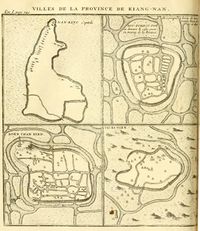
حين تحطم سفينة المسئول الكوري تشوى بو أتاح له فرصة رؤية الكثير من شرق الصين، من ژىجيانگ إلى لياوننگ، في طريق عودته إلى موطنه في 1488، وقد وصف سوژو في تقرير سفره بأنها تفوق كل المدن الأخرى.[24] الكثير من الجدائق الخاصة في المنطقة قد أنشأهم نبلاء أسرتي مينگ وتشينگ. استولى التايپنگ محطمو العقائد على المدينة في 1860، إلا أن مبانيها وحدائقها الغناء السابقة أضحت "تقريباً... كومة من الأطلال"[20] بحلول الوقت الذي استعادها فيه الجيش المنتصر دوماً بقيادة تشارلز جورج گوردون في نوفمبر 1863.[21] إلا أنه بحلول 1880، قـُدِّر أن عدد سكانها قد عاد لماضيه فناهز 500,000 نسمة،[20] والذي ظل مستقراً للعقود التالية.[21] وفي أواخر القرن التاسع عشر، اشتهرت المدينة بشكل خاص بنطاق واسع من أنواع الحرير وصناعة النشر باللغة الصينية.[20] انفتحت المدينة لأول مرة على التجارة الأجنبية تنفيذاً لـمعاهدة شيمونوسكي لإنهاء الحرب الصينية اليابانية الأولى[21] وببنود الأمة الأكثر تفضيلاً في المعاهدات غير المتكافئة السابقة مع القوى العظمى. فتح الأجانب الجدد مدرسة أوروپية وصينية في 1900 وفتحوا محطة سكك حديد سوژو، التي ربطتها مع شانغهاي[21] في 16 يوليو 1906. وقبل بداية الحرب العالمية الأولى مباشرة، كان هناك 7000 بوبينة حرير تعمل، وكذلك مغزل للقطن وتجارة كبيرة في الأرز.[21]
وأخيراً في مطلع القرن العشرين، كان معظم المدينة يتكون من جزر تربطها الأنهار والغدائر والقنوات بالريف المحيط بها.[21] وقبل إزالتها، كانت أسوار المدينة تجري في دائرة طولها 16 كيلومتر بأربع ضواحي كبيرة تقع خارج ذلك السور.[21] اليابانيون غزوها في 1937، ودُمـِّرت الكثير من الحدائق مرة أخرى بنهاية تلك الحرب. وفي مطلع ع1950، تم ترميم حديقة الاداري المتواضع و الحديقة الباقية.
التقسيمات الادارية
القلب الحضري لسوژو يُطلق عليه بشكل غير رسمي "البلدة القديمة". وهي مديرية گوسو. منطقة سوژو الصناعية تقع إلى الشرق من البلدة القديمة، و منطقة سوژو للتكنولوجيا العالية والحديثة تقع إلى الغرب. في 2000، انقسمت ناحية وو الأصلية إلى مديريتين هما شيانگتشنگ و ووژونگ. والآن يشكلون الأجزاء الشمالية والجنوبية لمدينة سوژو. وفي 2012، مدينة ووجيانگ أصبحت مديرية ووجيانگ داخل مدينة سوژو.
سوژو هي واحدة من أكثر المدن ازدهاراً في الصين. ونموها مرتبط مباشرةً بنمو مدنها الساتلة، وهم كونشان و تايتسانگ وچانگشو و ژانگجياگانگ، الذين يشكلون مع مدينة سوژو "محافظة سوژو". محافظة سوژو هي مقر العديد من شركات التكنولوجيا المتقدمة.
| الخريطة | |||||
|---|---|---|---|---|---|
| التقسيم | الصينية المبسطة | هانيو پنين | التعداد (2010) | المساحة (كم²) | الكثافة (/كم²) |
| المدينة نفسها | |||||
| مديرية گوسو | 姑苏区 | Gūsū Qū | 954,455 | 372 | 2,565.73 |
| الضواحي | |||||
| مديرية هوچيو | 虎丘区 | Hǔqiū Qū | 572,313 | 258 | 2,218.26 |
| مديرية ووژونگ | 吴中区 | Wúzhōng Qū | 1,158,410 | 672 | 1,723.82 |
| مديرية شيانگتشنگ | 相城区 | Xiāngchéng Qū | 693,576 | 416 | 1,667.25 |
| مديرية ووجيانگ | 吴江区 | Wújiāng Qū | 1,275,090 | 1,093 | 1,166.59 |
| المدن الساتلة (مدن بمستوى ناحية) | |||||
| مدينة چانگشو | 常熟市 | Chángshú Shì | 1,510,103 | 1,094 | 1,380.35 |
| مدينة تايتسانگ | 太仓市 | Tàicāng Shì | 712,069 | 620 | 1,148.49 |
| مدينة كونشان | 昆山市 | Kūnshān Shì | 1,646,318 | 865 | 1,903.25 |
| مدينة ژانگجياگانگ | 张家港市 | Zhāngjiāgǎng Shì | 1,248,414 | 772 | 1,617.11 |
| الإجمالي | 10,465,994 | 8,488 | 1,233.03 | ||
| ليست تقسيمات ادارية رسمية – منطقة سوژو الصناعية و مديرية سوژو الجديدة مديريات سابقة – مديرية تسانگلانگ و مديرية پينگجيانگ و مديرية جينتشانگ | |||||
الجغرافيا
تقع سوژو في سهل بحيرة تاي، جنوب نهر يانگتسى، بعد بعد نحو 100 كيلومتر غرب شانغهاي وما يزيد قليلاً على 200 كيلومتر شرق نانجينگ.
المناخ
تتمتع سوژو مناخ شبه مداري رطب ذي أربع فصول with hot, humid summers and cool, cloudy, damp winters with occasional snowfall (Köppen climate classification Cfa). Northwesterly winds blowing from Siberia during winter can cause temperatures to fall below freezing at night, while southerly or southwesterly winds during the summer can push temperatures above 35 °C (95 °F). The hottest temperature recorded since 1951 was at 41.0 °C (106 °F) on 7 August 2013,[25] and the lowest at −9.8 °C (14 °F) on 16 January 1958.[26]
| أخفمتوسطات الطقس لسوژو | |||||||||||||
|---|---|---|---|---|---|---|---|---|---|---|---|---|---|
| شهر | يناير | فبراير | مارس | أبريل | مايو | يونيو | يوليو | أغسطس | سبتمبر | اكتوبر | نوفمبر | ديسمبر | |
| متوسط العظمى °م (°ف) | 8 (46) | 10 (50) | 13 (55) | 20 (68) | 24 (75) | 28 (82) | 32 (90) | 31 (88) | 28 (82) | 22 (72) | 17 (63) | 11 (52) | |
| متوسط الصغرى °م (°ف) | 2 (36) | 4 (39) | 7 (45) | 12 (54) | 17 (63) | 22 (72) | 26 (79) | 26 (79) | 22 (72) | 17 (63) | 11 (52) | 5 (41) | |
| هطول الأمطار cm (بوصة) | 7.75 (3.1) | 5.06 (2) | 9.43 (3.7) | 7.17 (2.8) | 9.33 (3.7) | 19.62 (7.7) | 11.66 (4.6) | 22.46 (8.8) | 7.07 (2.8) | 5.86 (2.3) | 4.91 (1.9) | 4.85 (1.9) | |
| المصدر: per MSN 2008 | |||||||||||||
أفق المدينة والبيئة
سوژو كما تبدو من Beisi Pagoda
الحدائق الكلاسيكية في سوژو
تشتهر سوژو بوجود أكثر من 60 حديقة كلاسيكية، معاً تعتبرهم اليونسكو موقع تراث عالمي. المدينة تضم أكبر عدد من الحدائق المعترف بها من قِبل اليونسكو في العالم.[27]
حديقة الاداري المتواضع و الحديقة العالقة هم بين أشهر الحدائق الكلاسيكية في الصين. مقصورة تسانگلانگ و بستان الأسد، وحديقة الاداري المتواضع والحديقة العالقة، هم بالترتيب يمثلون أنماط الحدائق في أسر سونگ، و يوان، و مينگ، و تشينگ، ويُسمون أشهر أربع حدائق في سوژو. الحدائق الأخرى المدرجة في قائمة مواقع التراث العالمي تضم حديقة مهجع الزوجين، و حديقة الزراعة، و Retreat and Reflection Garden.
المعابد
- Hanshan Temple
- Xiyuan Temple
- Xuanmiao Temple
- Lingyanshan Temple
- Chongyuan Temple
- Taipingfang Mosque (太平坊清真寺)
القنوات والمديريات التاريخية
The Suzhou section of the Jiangnan Canal, Grand Canal (China), includes ten city gates and over 20 stone bridges of traditional design and historic areas that have been well preserved, as well as temples and pavilions. [28][29] [30] There are a full 24 waterways in Suzhou near the Grand Canal.[31]
In 2015, both 800-year-old Pingjiang Road Historical Block (平江路) and 1,200-year-old Shantang Street Scenic Area (山塘街) were added to the list of China's "National Historic and Cultural Streets".[32][33]
Pingjiang Road runs parallel to the Pingjiang River for 1.5 kilometers and is lined with homes and some teahouses. Shantang Street, over twice as long at 3.8 km, is described by the BBC as retaining "the alluring qualities of an old canal-side street: whitewashed buildings are completed by red-tasselled lanterns that swing softly in the breeze, adding to the charm of the river bank".[31]
Boat tours are offered on the waterways of this city that was dubbed the "Venice of the East" by Marco Polo because of its criss-crossing canals and stone bridges.[34][35] The Grand Canal (from Beijing to Zhejiang province) is a UNESCO World Heritage site.
المنتجعات والمحميات الطبيعية
Suzhou Taihu National Tourism and Vacation Zone (苏州太湖国家旅游度假区) is in the western part of Suzhou, 15 km (9 mi) from the city center.[36][37]
ناطحات السحاب
Gate to the East is a 301.8 meter, 74-story skyscraper in Suzhou's central business district, built in 2015 at a cost of 700 million USD and is currently the tallest building in Suzhou.[38]
بوابة پان
Pan Gate (盘门) is on the southwest corner of the Main Canal or encircling canal of Suzhou. Originally built during the Warring States Period in the state of Wu, historians estimate it to be around 2,500 years old. It is now part of the Pan Gate Scenic Area. It is known for the "three landmarks of Pan Gate". They are the Ruiguang Pagoda(瑞光塔), the earliest pagoda in Suzhou built in 247 BC, the Wu Gate Bridge, the entrance to the gate at that time over the water passage and the highest bridge in Suzhou at the time, and the Pan Gate. The Ruigang Pagoda is constructed of brick with wooden platforms and has Buddhist carvings at its base.
جسر باوداي
Baodai Bridge (宝带桥; 'Precious Belt Bridge') stretches across the Tantai Lake in the suburbs of Suzhou. To raise money to finance the bridge, the magistrate donated his expensive belt, hence the name. The bridge was first built in 806 A.D. in the Tang Dynasty and has 53 arches with a length of 317 meters. It was made out of stone from Jinshan Mountain and is the longest standing bridge of its kind in China. The bridge was included on the list of national monuments (resolution 5-285) in 2001.
ربوة النمر
The Tiger Hill is known for its natural environment and historical sites. The hill is so named because it is said to look like a crouching tiger. Another legend states that a white tiger appeared on the hill to guard it following the burial The hill has been a tourist destination for hundreds, if not thousands, of years, as is evident from the poetry and calligraphy carved into rocks on the hill. The Song Dynasty poet, Su Shi said, "It is a lifelong pity if having visited Suzhou you did not visit Tiger Hill."
الپاگودات
Yunyan Pagoda (虎丘塔 or 云岩寺塔), built in 961, is a Chinese pagoda built on Tiger Hill in Suzhou. It has several other names, including the "Leaning Tower of China" (as referred to by historian O.G. Ingles)[39] and the Yunyan Temple Tower. The tower rises to a height of 47 m (154 ft). It is a seven-story octagonal building built with blue bricks. In more than a thousand years the tower has gradually slanted due to forces of nature. Now the top and bottom of the tower vary by 2.32 meters. The entire structure weighs some 7,000,000 kilograms (15,000,000 lb), supported by internal brick columns.[40] However, the tower leans roughly 3 degrees due to the cracking of two supporting columns.[40]
Beisi Pagoda(北寺塔) or North Temple Pagoda is a Chinese pagoda at Bao'en Temple in Suzhou. It rises nine stories in a height of 76 m (249 ft). It is the tallest Chinese pagoda south of the Yangtze river.
Twin Pagodas (苏州双塔) lie in the Dinghui Temple Lane in the southeastern corner of the city proper of Suzhou. They are artistic and natural as they are close at hand. One of them is called Clarity-Dispensing Pagoda and the other Beneficence Pagoda and they are in the same form of building. There are many legends about the one-thousand-year-old pagodas. It is charming that the exquisite and straight Twin Pagoda look like two inserted writing brushes. There was originally a single-storey house with three rooms just like a writing brush holder with the shadows of the two pagodas reclining on its roof at sunset. To the east of the pagoda is a square five-storeyed bell building built in the Ming Dynasty which is exactly like a thick ink stick. So there is a saying that "the Twin Pagodas are as writing brushes while the bell building as ink stick".
المتاحف
The city's major museums include the Suzhou Museum (designed by I. M. Pei), Suzhou Silk Museum, and Suzhou Museum of Opera and Theatre.
الاقتصاد
اقتصاد سوژو يقوم أساساً على قطاع التصنيع الكبير—وهو الثاني في الصين—بما في ذلك الحديد والصلب، تكنولوجيا المعلومات، والنسيج. قطاع الخدمات في المدينة متطور جداً، خصوصاً بسبب السياحة، التي جلبت للمدينة إجمالي 152 بليون يوان من الدخل في 2013. الناتج المحلي الإجمالي العمومي لسوژو يفوق 1.3 تريليون يوان في 2013 (بارتفاع 9.6% عن السنة السابقة).[41]
المدينة هي واحدة من أهم مقاصد الاستثمار الأجنبي، وذلك لقربها النسبي لشانغهاي والتكلفة المنخفضة نسبياً للتشغيل فيها. وقد فعـَّلت الحكومة البلدية العديد من الإجراءات لتشجيع الاستثمار المباشر الأجنبي في عدد من قطاعات التصنيع (مثل الأدوية والإلكترونيات والسيارات) وقطاع الخدمات (مثل الصيرفة والنقل وخدمات الأبحاث). وضمن تلك الإجراءات نجد سياسة ضريبية تفضيلية للشركات المحدودة لرأس المال المخاطر في منطقة سوژو الصناعية.[41]
مناطق التنمية
المنطقة الصناعية في سوژو
المنطقة الصناعية في سوژو (SIP) هو أكبر مشروع تعاوني بين الحكومتين الصينية والسنغافورية. وتقع بجانب بحيرة جنجي، إلى الشرق من مدينة سوژو القديمة. ففي 26 فبراير 1994، نائب رئيس الوزراء لي لانچينگ والوزير الأكبر لي كوان يو مثلا الصين وسنغافورة بالترتيب في توقيع الاتفاقية للتطوير المشترك للمنطقة الصناعية في سوژو (التي كانت تسمى في الأصل المنطقة الصناعية السنغافورية). المشروع بدأ رسمياً في 12 مايو من نفس العام. وقد خُصصت له أرض مساحتها 288 كم²، منها منطقة التعاون الصيني-السنغافوري تغطي 80 كم² بتعداد سكان مزمع 1.2 مليون نسمة.[42]
المنطقة الصناعية في سوژو هي مقر منطقة بحيرة دوشو بسوژو للإبداع في العلوم والتعليم، وهي منطقة للجامعات و مؤسسات التعليم العالي، بما في ذلك جامعة سوتشو (苏州大学) و جامعة شيآن جياوتونگ-ليڤرپول (西交利物浦大学).
قسم تجهيز صادرات المنطقة الصناعية في سوژو
The Suzhou Industrial Park Export Processing Zone was approved to be established by the government in April 2000, with a planning area of 2.9 km2 (1.1 sq mi). It is in Suzhou Industrial Park set up by China and Singapore. Inside the Export Processing Zone, all the infrastructures are of high standard.[43]
مديرية سوژو الحديثة
The Suzhou New District was established in 1990. In November 1992, the zone was approved to be the national-level hi-tech industrial zone. By the end of 2007, foreign-invested companies had a registered capital worth of US$13 billion, of which US$6.8 billion was paid in. SND hosts now more than 1,500 foreign companies. Some 40 Fortune 500 companies set up 67 projects in the district.[44]
الثقافة
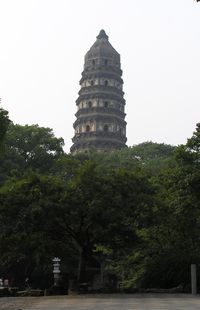
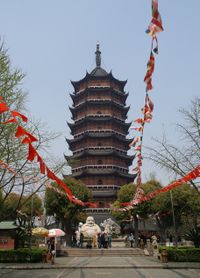
- Opera: Kunqu originates in the Suzhou region, as does the much later Suzhou Opera. Ballad-singing, or Suzhou pingtan, is a local form of storytelling that mixes singing (accompanied by the pipa and sanxian) with portions in spoken dialect.
- Silk: throughout China's Imperial past, Suzhou silk has been associated with high-quality silk products, supplying silks to ancient royal families. By the 13th century, Suzhou was already the center of the profitable silk trade.
- Song brocade: Suzhou's Song brocade, with its flashy colors, exquisite patterns, strong and soft texture, is one of China's three famous brocades, together with Nanjing Yun brocade and Sichuan Shu brocade. Suzhou's brocade production can be traced back to the Five Dynasties. It prospered in the Song Dynasty. After the government moved the capital southward, the country's political and cultural center moved to the Yangtze River area. To cope with the special need of artists, a type of very thin brocade for decorating paintings emerged in Suzhou. These brocades and paintings have been preserved. Whenever people talked about brocade, they mentioned the Song Dynasty, and thus Song brocade got its name and has been well-known ever since.[بحاجة لمصدر]
- Handicrafts: Suzhou embroidery, fans, Chinese musical instruments, scroll mounting, lanterns, mahogany furniture, jade carving, silk tapestry, traditional painting pigments of Jiangenxutang Studio, the New Year's wood-block prints of Taohuawu Studio.
- Paintings
- Calligraphic art
- Cuisine: Yangcheng Lake large crab
- Suzhou Silk Hand Embroidery Art
- Suzhou is the original place of "Jasmine", a song sung by Chinese singers or actresses thousands of times on the occasions of almost every important meetings or celebrations. Jasmine is the symbol of Suzhou as well as Tai Hu Lake.
- Suzhou Gardens: Gardens in Suzhou have an ancient history. The first garden in Suzhou belonged to the emperor of Wu State in Spring and Autumn Period (600 BC). More than 200 gardens existed in Suzhou between the 16th and 18th centuries. Gardens in Suzhou were built according to the style of Chinese Paintings. Every view in a garden can be seen as a piece of Chinese Painting and the whole garden is a huge piece of Chinese Paintings. At present, the Humble Administrator's Garden, built in 16th, is the largest private garden in Suzhou. It belonged to by Wang Xianchen, an imperial censor.
- Suzhou embroidery together with embroidery of Hunan, Sichuan and Guangdong are called as the "Four Famous Embroideries". Suzhou tapestry method is done in fine silks and gold thread. Other art forms found in this area are sculpture, Song brocade, jade and rosewood carving.
- The Suzhou Museum has a rich collection of relics from many eras. The collection includes revolutionary records, stele carving, folk customs, drama and verse, Suzhou embroidery, silk cloth, gardens, coins and Buddhist artifacts.[45]
العلاقات الدولية
المدن الشقيقة
سوژو (تضم 7 مديريات و 5 مدن بمستوى ناحية، ضمن ادارة سوژو) لديها أكثر من 50 مدينة شقيقة وبلدة توأم ومقاطعة شقيقة:
مراجع
وصلات خارجية
- Official site of Suzhou City
- Official travel and tourism website of Suzhou
- Suzhou city guide with open directory (Jiangsu Network)
- Suzhou Industrial Park
- Suzhou City Guide Suzhou in context
| أظهر أكبر مدن أو بلديات في جمهورية الصين الشعبية
China Urban Construction Statistical Yearbook 2020 Urban Population and Urban Temporary Population |
|---|
- ^ "Table showing land area and population". Suzhou People's Government. 2003. Archived from the original on 2 ديسمبر 2007. Retrieved 7 سبتمبر 2007.
{{cite web}}: Unknown parameter|dead-url=ignored (|url-status=suggested) (help) - ^ أ ب
Calculated using data from Suzhou Statistics Bureau. Life Expectancy Index = 0.9672, Education Index = 0.8244, Income Index = 0.896. Refs:
- Suzhou Bureau of Statistics (苏州市统计局). "Archived copy" 2016年苏州市情市力 (PDF). Archived from the original (PDF) on 14 مارس 2017. Retrieved 13 مارس 2017.
{{cite web}}: Unknown parameter|dead-url=ignored (|url-status=suggested) (help)CS1 maint: archived copy as title (link) - "Archived copy" 新建改扩建410所学校 苏州教育有"国际范". Tencent. Archived from the original on 14 مارس 2017. Retrieved 13 مارس 2017.
{{cite web}}: Unknown parameter|dead-url=ignored (|url-status=suggested) (help)CS1 maint: archived copy as title (link) - "Archived copy" 苏州人均期望寿命高于北京上海 癌症仍是"头号杀手". 城市商报. 22 أبريل 2016. Archived from the original on 3 أكتوبر 2017. Retrieved 5 أكتوبر 2016.
{{cite news}}: Unknown parameter|dead-url=ignored (|url-status=suggested) (help)CS1 maint: archived copy as title (link)
- Suzhou Bureau of Statistics (苏州市统计局). "Archived copy" 2016年苏州市情市力 (PDF). Archived from the original (PDF) on 14 مارس 2017. Retrieved 13 مارس 2017.
- ^ "Archived copy" 苏U号牌来了!苏州将成江苏首个启用双号牌的城市. 交汇点. 24 أكتوبر 2018. Archived from the original on 24 أكتوبر 2018. Retrieved 24 أكتوبر 2018.
{{cite web}}: Unknown parameter|dead-url=ignored (|url-status=suggested) (help)CS1 maint: archived copy as title (link) - ^ أ ب Suzhou Bureau of Statistics. 2014年苏州市情市力 (PDF). Archived from the original (PDF) on 19 أبريل 2014. Retrieved 19 أبريل 2014.
{{cite web}}: Unknown parameter|deadurl=ignored (|url-status=suggested) (help) - ^ بضم المناطق المجاورة والمدن الساتلة كونشان، و ژانگجياگانگ، و تايتسانگ، و چانگشو. هذه العبارة مبنية على بيانات من الحكم المحلي، بينما يزعم تقرير للأمم المتحدة (انظر أدناه) أن تعدادها (الحضري) كان 5.156 مليون نسمة في 2014.
- ^ United Nations, Department of Economic and Social Affairs, Population Division. "World Urbanization Prospects: The 2014 Revision" (PDF). Archived from the original (PDF) on 2 نوفمبر 2014. Retrieved 1 يناير 2015.
{{cite web}}: Unknown parameter|dead-url=ignored (|url-status=suggested) (help)CS1 maint: multiple names: authors list (link) - ^ Elizabeth MacBride (22 ديسمبر 2014). "Keep an eye on these emerging market cities". CNBC. Archived from the original on 1 يناير 2015. Retrieved 1 يناير 2015.
{{cite news}}: Unknown parameter|dead-url=ignored (|url-status=suggested) (help) - ^ Tertius Chandler (1987). Four Thousand Years of Urban Growth: An Historical Census. St. David's University Press. ISBN 978-0889462076.
- ^ "Top 10 Cities of the Year 100". About.com. Archived from the original on 5 أكتوبر 2013. Retrieved 20 أكتوبر 2013.
{{cite web}}: Unknown parameter|dead-url=ignored (|url-status=suggested) (help) - ^ "The Grand Canal". UNESCO World Heritage Center. Archived from the original on 2 يناير 2014. Retrieved 1 يناير 2014.
{{cite web}}: Unknown parameter|dead-url=ignored (|url-status=suggested) (help) - ^ Marme, Michael (2005). Suzhou: Where the Goods of All the Provinces Converge. Stanford: Stanford University Press. ISBN 9780804731126.
- ^ Xu (2000), pp. 16, 72–73, 159.
- ^ "Archived copy" 寻梦苏州 探寻一座城市的现代化之路. 人民网. 26 يناير 2005. Archived from the original on 14 أكتوبر 2013. Retrieved 27 أغسطس 2013.
{{cite news}}: Unknown parameter|dead-url=ignored (|url-status=suggested) (help)CS1 maint: archived copy as title (link) - ^ Visit some of China's best gardens next week without a passport » Arts/Entertainment » Andover Townsman, Andover, MA. Andovertownsman.com. Retrieved on 2011-08-28.
- ^
Thorpe, Annabelle. "Suzhou: Real China outside Shanghai". The Times. London. Archived from the original on 4 يونيو 2011. Retrieved 24 مايو 2010.
{{cite news}}: Unknown parameter|dead-url=ignored (|url-status=suggested) (help) - ^
Fussell, Betty (13 مارس 1988). "Exploring Twin Cities By Canal Boat". The New York Times. Archived from the original on 1 يوليو 2017. Retrieved 24 مايو 2010.
{{cite news}}: Unknown parameter|dead-url=ignored (|url-status=suggested) (help) - ^ "Supplement to the Local Gazetteer of Wu Prefecture". World Digital Library. 1134. Archived from the original on 12 ديسمبر 2013. Retrieved 6 سبتمبر 2013.
{{cite web}}: Unknown parameter|dead-url=ignored (|url-status=suggested) (help) - ^ Suzhou Archived 6 أكتوبر 2014 at the Wayback Machine, China Daily
- ^ "Suzhou, Jiangsu, China". suzhou.jiangsu.net. Archived from the original on 23 أبريل 2013. Retrieved 3 أبريل 2013.
{{cite web}}: Unknown parameter|dead-url=ignored (|url-status=suggested) (help) - ^ أ ب ت ث ج EB (1887).
- ^ أ ب ت ث ج ح خ د EB (1911).
- ^ The old editions of the Britannica give the erroneous date of AD 484.[20][21]
- ^ Xu (2000), pp. 34–36.
- ^ Brook, Timothy. The Confusions of Pleasure: Commerce and Culture in Ming China. Berkeley: University of California Press, 1988. ISBN 0-520-22154-0. Page 45.
- ^ 中国江苏网 Archived 5 يناير 2016 at the Wayback Machine [Míngchéng Xīnwén Wǎng, City News Online]. 《昨最高气温再创历史新高 苏州筹划人工增雨降温》 Archived 4 أغسطس 2013 at the Wayback Machine ["Yesterday was highest temperature on record, Suzhou planning artificial rain to cool".] 1 Aug 2013. Accessed 20 Jan 2014. (صينية)
- ^ 中国苏州 Archived 23 أكتوبر 2004 at the Wayback Machine [Zhōngguó Sūzhōu, Suzhou Municipal Government Website]. 《苏州历史最高最低气温问题》 Archived 1 فبراير 2014 at the Wayback Machine ["Question about Suzhou's Highest and Lowest Temperature Records"]. 20 Jan 2011. Accessed 20 Jan 2014. (صينية)
- ^ "Archived copy". Archived from the original on 25 نوفمبر 2018. Retrieved 24 نوفمبر 2018.
{{cite web}}: Unknown parameter|dead-url=ignored (|url-status=suggested) (help)CS1 maint: archived copy as title (link) - ^ "The Grand Canal". Visit Our China. Archived from the original on 26 نوفمبر 2018. Retrieved 26 نوفمبر 2018.
- ^ "Suzhou Grand Canal – Golden Waterway in China". China Discovery. Archived from the original on 26 نوفمبر 2018. Retrieved 26 نوفمبر 2018.
- ^ Gang Xu. Tourism and Local Development in China: Case Studies of Guilin, Suzhou and Beidaihe. p. 47. Archived from the original on 26 نوفمبر 2018. Retrieved 26 نوفمبر 2018.
- ^ أ ب "Suzhou: China's Canal Capital". BBC Travel. Archived from the original on 25 نوفمبر 2018. Retrieved 24 نوفمبر 2018.
- ^ "Official Travel and Tourism Website for Suzhou". en.visitsz.com. Archived from the original on 26 يونيو 2018. Retrieved 27 ديسمبر 2018.
- ^ "Historical streets in Jiangsu listed as national heritage". China Daily. Archived from the original on 26 نوفمبر 2018. Retrieved 26 نوفمبر 2018.
- ^ "Suzhou --'Venice in the Orient'". China Internet Information Center. Archived from the original on 29 مايو 2017. Retrieved 24 نوفمبر 2018.
- ^ "A city called the 'Venice of the East'". Shanghai Daily. Archived from the original on 24 نوفمبر 2018. Retrieved 24 نوفمبر 2018.
- ^ "Archived copy" 苏州太湖旅游度假区顺利晋级5A级景区. Archived from the original on 15 سبتمبر 2016. Retrieved 30 يوليو 2016.
{{cite web}}: CS1 maint: archived copy as title (link) - ^ "Archived copy" 苏州太湖国家旅游度假区中心区控制性详细规划公示. Archived from the original on 12 يونيو 2018. Retrieved 30 يوليو 2016.
{{cite web}}: CS1 maint: archived copy as title (link) - ^ "$700 million skyscraper 'resembles a pair of pants'". Archived from the original on 31 مايو 2016. Retrieved 30 يوليو 2016.
- ^ Ingles (1982), 144.
- ^ أ ب Ingles (1982), 145.
- ^ أ ب "China Regional Focus: Suzhou, Jiangsu Province" Archived 8 مايو 2014 at the Wayback Machine, China Briefing, Shanghai, 02 May 2014.
- ^ Rightsite.asi | Suzhou Industry Park Archived 25 مارس 2010 at the Wayback Machine. Rightsite.asia (1994-02-26). Retrieved on 2011-08-28.
- ^ Rightsite.asia | Suzhou Industrial Park Export Processing Zone[dead link]
- ^ Suzhou Hi-Tech Industrial Development Zone Archived 22 أبريل 2010 at the Wayback Machine. Rightsite.asia. Retrieved on 2011-08-28.
- ^ "Suzhou Museum". Archived from the original on 28 أبريل 2009.
- ^ "Twin cities of Riga". Riga City Council. Retrieved 2009-07-27.
- Pages using gadget WikiMiniAtlas
- Articles with hatnote templates targeting a nonexistent page
- Short description is different from Wikidata
- Coordinates on Wikidata
- Articles containing صينية-language text
- جميع المقالات التي فيها عبارات متقادمة
- Articles containing Chinese-language text
- Articles containing simplified Chinese-language text
- Articles with unsourced statements from July 2018
- مدن جيانگسو
- مواقع التراث العالمي في الصين
- سوژو
- دلتا نهر يانگتسي
- تقسيمات بمستوى محافظة في جيانگسو
- أماكن مأهولة تأسست في القرن السادس ق.م.
- موانئ الصين
- جيانگنان
- Alliance for Healthy Cities
- مدن صينية
- صفحات مع الخرائط
- CS1 errors: unsupported parameter
- CS1 uses الصينية-language script (zh)
- Harv and Sfn no-target errors
- Articles with dead external links from June 2016



